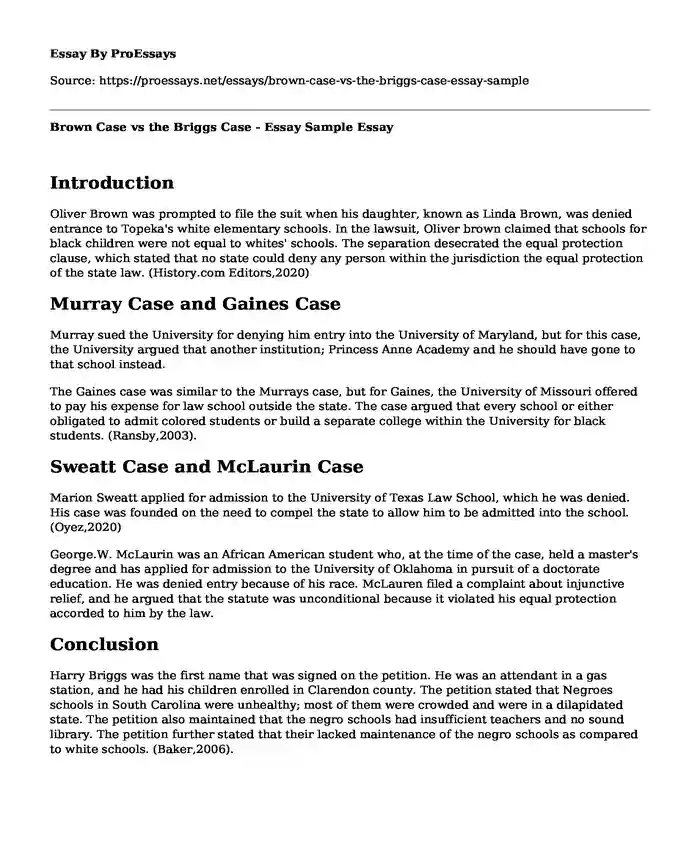Introduction
Oliver Brown was prompted to file the suit when his daughter, known as Linda Brown, was denied entrance to Topeka's white elementary schools. In the lawsuit, Oliver brown claimed that schools for black children were not equal to whites' schools. The separation desecrated the equal protection clause, which stated that no state could deny any person within the jurisdiction the equal protection of the state law. (History.com Editors,2020)
Murray Case and Gaines Case
Murray sued the University for denying him entry into the University of Maryland, but for this case, the University argued that another institution; Princess Anne Academy and he should have gone to that school instead.
The Gaines case was similar to the Murrays case, but for Gaines, the University of Missouri offered to pay his expense for law school outside the state. The case argued that every school or either obligated to admit colored students or build a separate college within the University for black students. (Ransby,2003).
Sweatt Case and McLaurin Case
Marion Sweatt applied for admission to the University of Texas Law School, which he was denied. His case was founded on the need to compel the state to allow him to be admitted into the school. (Oyez,2020)
George.W. McLaurin was an African American student who, at the time of the case, held a master's degree and has applied for admission to the University of Oklahoma in pursuit of a doctorate education. He was denied entry because of his race. McLauren filed a complaint about injunctive relief, and he argued that the statute was unconditional because it violated his equal protection accorded to him by the law.
Conclusion
Harry Briggs was the first name that was signed on the petition. He was an attendant in a gas station, and he had his children enrolled in Clarendon county. The petition stated that Negroes schools in South Carolina were unhealthy; most of them were crowded and were in a dilapidated state. The petition also maintained that the negro schools had insufficient teachers and no sound library. The petition further stated that their lacked maintenance of the negro schools as compared to white schools. (Baker,2006).
References
Baker, R. S. (2006). Paradoxes of desegregation: African American struggles for educational equity in Charleston, South Carolina, 1926-1972. Univ of South Carolina Press.
https://academic.oup.com/jah/article-abstract/94/2/572/730235
History.com Editors (2020, October 3). Brown v. Board of Education.History
https://www.history.com/topics/black-history/brown-v-board-of-education-of-topeka
Ransby, B. (2003). Ella Baker and the black freedom movement: A radical democratic vision. Rights. Boston, MA: Beacon Press.
https://www.ejournals.eu/Studia-Migracyjne/2020/2(176)/art/17297
Sweatt v. Painter. (n.d.). Oyez. Retrieved October 3, 2020, from
https://www.oyez.org/cases/1940-1955/339us629.
Cite this page
Brown Case vs the Briggs Case - Essay Sample. (2024, Jan 01). Retrieved from https://proessays.net/essays/brown-case-vs-the-briggs-case-essay-sample
If you are the original author of this essay and no longer wish to have it published on the ProEssays website, please click below to request its removal:
- Paper Example on Unlawful Deportation
- Retributive Justice Essay Example
- Changes in Laws Towards a Fair Criminal Justice System Essay Example
- Hate Crime: Harassment, Intimidation, & Violence Motivated by Bias - Research Paper
- Essay Sample on Exploring the Impact of US Federal Immigration Policies on Local Governments
- Preventing Sexual Assault in the Workplace: Types and Implications - Essay Sample
- Paper Sample on Free Movement: A Possible Solution to Global Poverty







